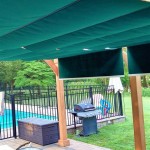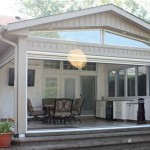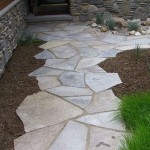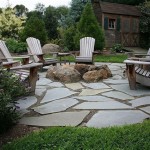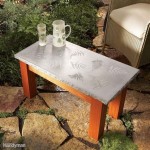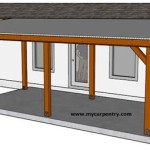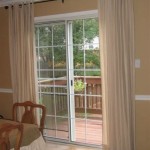Ways to Cover a Concrete Patio
A concrete patio offers a durable and versatile outdoor space, but its aesthetic appeal can sometimes fall short. A bare concrete slab can feel cold, impersonal, and even unattractive. Fortunately, numerous options exist to cover a concrete patio, transforming it into a stylish and inviting extension of the home. These coverings range in price, installation complexity, and maintenance requirements, allowing homeowners to choose the best solution for their budget, skills, and lifestyle. This article explores various methods of covering concrete patios, providing information to aid in informed decision-making.
Paint and Stains
One of the most cost-effective and straightforward approaches to enhancing a concrete patio is through the application of paint or stain. These coverings offer a relatively simple way to dramatically alter the patio's appearance, adding color, texture, and visual interest. The preparation required for this method is critical for optimal results. The concrete surface must be thoroughly cleaned and any cracks or imperfections filled. A primer, specifically designed for concrete, should be applied to ensure proper adhesion of the paint or stain.
Concrete paint is available in a vast array of colors and finishes, allowing for complete customization of the patio's aesthetic. Epoxy paints offer increased durability and resistance to abrasion, making them a suitable choice for high-traffic areas. However, epoxy paints tend to be more expensive and may require more specialized application techniques. Acrylic paints are another viable option, providing good coverage and durability at a more affordable price point.
Concrete stains, unlike paints, penetrate the concrete surface, creating a translucent color that highlights the natural variations and texture of the material. Acid stains react chemically with the concrete, producing mottled, earth-toned effects. Water-based stains offer a wider range of color options and are more environmentally friendly than acid stains. Both types of stains offer a permanent color that will not peel or chip, though they may fade over time with exposure to the elements. Sealing is essential after staining to protect the color and prevent water damage.
Both paint and stain options require periodic maintenance, including cleaning and resealing. The frequency of resealing depends on the level of traffic and exposure to the elements. Regular cleaning with a mild detergent and water will help to maintain the appearance of the painted or stained surface.
Outdoor Rugs and Mats
For a temporary and easily changeable solution, outdoor rugs and mats provide an immediate visual upgrade to a concrete patio. These coverings come in a wide variety of styles, colors, and sizes, allowing homeowners to quickly and affordably transform the look and feel of their outdoor space. Outdoor rugs are typically made from durable, weather-resistant materials such as polypropylene, olefin, or recycled plastic, making them suitable for outdoor use.
The primary advantage of using outdoor rugs and mats is their ease of installation. No special tools or skills are required; simply unroll the rug and position it on the patio. This allows for quick changes in decor and the ability to easily remove the rugs for cleaning or storage. Outdoor rugs can also help to define specific zones within the patio, such as a dining area or a seating area.
While convenient and aesthetically pleasing, outdoor rugs and mats do require some maintenance. They should be regularly cleaned to remove dirt, debris, and mildew. Depending on the material, this may involve sweeping, hosing down, or using a mild detergent. It is also important to ensure that the rug is properly dried after cleaning to prevent the growth of mold and mildew. In areas with heavy rainfall or snow, storing the rugs during inclement weather can extend their lifespan.
The use of a rug pad beneath the outdoor rug is recommended. A rug pad provides added cushioning, prevents the rug from slipping, and helps to protect the concrete surface from scratches. It also allows for better air circulation under the rug, which can help to prevent the build-up of moisture and mildew.
Tiles and Pavers
For a more permanent and upscale solution, tiles and pavers offer a durable and aesthetically pleasing way to cover a concrete patio. These materials provide a wide range of design options, allowing homeowners to create a customized outdoor space that complements their home's architecture and personal style. Tiles and pavers are available in various materials, including porcelain, ceramic, natural stone, and concrete.
Porcelain tiles are a popular choice for outdoor patios due to their durability, water resistance, and low maintenance requirements. They are available in a wide range of colors, patterns, and sizes, and can mimic the look of natural stone or wood. Ceramic tiles are another affordable option, but they are typically less durable and more prone to cracking than porcelain tiles. Natural stone tiles, such as slate, travertine, and granite, offer a high-end, luxurious look. However, they tend to be more expensive and require more maintenance than porcelain or ceramic tiles.
Concrete pavers are a versatile and durable option for covering a concrete patio. They are available in a variety of shapes, sizes, and colors, and can be installed in various patterns. Interlocking pavers are designed to fit together snugly, creating a stable and durable surface. Concrete pavers are also relatively easy to install, making them a popular choice for DIY projects.
The installation of tiles or pavers on a concrete patio typically involves preparing the surface, laying a bed of mortar or sand, and then setting the tiles or pavers in place. Proper drainage is essential to prevent water from pooling on the patio surface, which can lead to damage over time. Grouting between the tiles or pavers helps to prevent weed growth and maintain the stability of the surface. Sealing the tiles or pavers is recommended to protect them from stains and water damage.
The primary disadvantage of using tiles or pavers is the cost and complexity of installation. These materials are generally more expensive than paint, stain, or outdoor rugs, and the installation process can be time-consuming and require specialized tools and skills. However, the long-term durability and aesthetic appeal of tiles and pavers make them a worthwhile investment for many homeowners.
Decking
Creating a deck over an existing concrete patio is a significant transformation that offers both aesthetic and functional benefits. Decking can elevate the patio into a more usable and attractive outdoor living space. This option provides a softer, more comfortable surface underfoot compared to concrete and can significantly alter the overall style of the area.
Several decking materials are available, each with its own advantages and disadvantages. Wood decking, such as cedar or redwood, offers a natural and warm appearance. However, wood decking requires regular maintenance, including staining or sealing, to protect it from the elements and prevent rot and decay. Composite decking, made from a combination of wood fibers and plastic, is a low-maintenance alternative to wood. Composite decking is resistant to rot, insects, and fading, and it does not require staining or sealing. However, it can be more expensive than wood decking.
The construction of a deck over a concrete patio typically involves building a frame or substructure to support the decking boards. This frame is usually constructed from pressure-treated lumber and is attached to the concrete patio using concrete anchors. The decking boards are then attached to the frame using screws or nails. Proper drainage is crucial during deck construction to prevent water from accumulating beneath the deck, which can lead to mold and mildew growth. Adequate ventilation is also essential to ensure that the wood or composite decking remains dry and healthy.
Building a deck over a concrete patio can be a complex project that requires specialized tools and skills. It is important to carefully plan the deck's design and ensure that it complies with local building codes. Homeowners may choose to hire a professional contractor to handle the construction of the deck, particularly if they lack experience in carpentry or construction.
A deck built over concrete provides a level of insulation against the cold concrete. This makes the patio more comfortable for bare feet and can help to extend the outdoor season. A deck can also be designed to incorporate features such as built-in seating, planters, or storage compartments, further enhancing the functionality of the outdoor space.
Epoxy Coatings
Epoxy coatings are a versatile option for covering a concrete patio, offering a durable, seamless, and aesthetically pleasing finish. Epoxy is a thermosetting resin that, when mixed with a hardener, creates a rigid, chemical-resistant surface. Epoxy coatings are available in a variety of colors, textures, and finishes, allowing for complete customization of the patio's appearance.
One of the primary advantages of epoxy coatings is their durability. Epoxy is highly resistant to abrasion, chemicals, and moisture, making it ideal for high-traffic areas. Epoxy coatings can also withstand extreme temperatures and are resistant to cracking and peeling. This makes them a long-lasting and low-maintenance option for covering a concrete patio.
Before applying an epoxy coating, the concrete surface must be thoroughly cleaned and prepared. Any cracks or imperfections should be filled, and the surface should be etched or ground to create a rough profile that will allow the epoxy to bond properly. A primer is typically applied to the concrete surface to improve adhesion.
The application of epoxy coatings requires specialized tools and techniques. The epoxy resin and hardener must be carefully mixed according to the manufacturer's instructions. The epoxy is then applied to the concrete surface using a roller or squeegee. Multiple coats may be required to achieve the desired thickness and finish. Epoxy coatings can be enhanced with decorative flakes, metallic pigments, or other additives to create a unique and customized look.
Epoxy coatings are relatively easy to clean and maintain. They can be cleaned with a mild detergent and water. Avoid using harsh chemicals or abrasive cleaners, as these can damage the epoxy surface. Epoxy coatings are also resistant to stains, making them a practical choice for outdoor patios that are prone to spills and messes.
While epoxy coatings offer numerous benefits, they can be more expensive than paint or stain. The application process can also be more complex and time-consuming, and it may require the assistance of a professional contractor. However, the long-term durability and aesthetic appeal of epoxy coatings make them a worthwhile investment for many homeowners seeking a high-quality and durable patio covering.

Diy Deck Over A Concrete Patio And Tips For Staining Your The Easy Way Love Color Design

Resurfacing A Concrete Patio For Budget Diy Makeover Fab Everyday

9 Ways To Cover A Concrete Patio

9 Great Concrete Patio Ideas For A Makeover Remodelaholic

10 Inexpensive Ways To Cover Concrete Patio

3 Inexpensive Ways To Cover Concrete Patio Designs Paint Diy

10 Inexpensive Ways To Cover A Concrete Patio Balcony Boss

Diy Concrete Patio Ideas

5 Ways To Upgrade Your Concrete Patio

Deck And Cover View Along The Way
Related Posts

